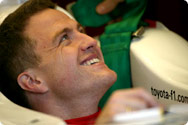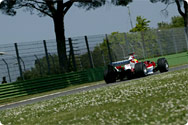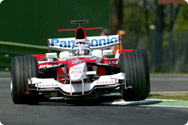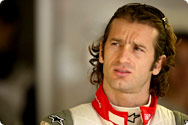As always, thank you for your continued support. Here is my report from
the San Marino Grand Prix, the fourth F1 race of the season.
My first visit to Imola. Going out and walking the course right away.
With our personnel change after the Australian Grand Prix, I’m sure
there are more than a few of you with concerns, but the team is going about business
as usual. We conducted testing at Paul Ricard and Barcelona, which, I am happy
to report, we were able to complete in good order.
The Paul Ricard tests, conducted the week after the Australian GP, focused
mainly on tires, looking toward the next race at Imola. With the European round
upon us, we will be facing several circuits that demand more downforce, and given
that top speeds at the prior race were somewhat low, we also went through tests
to help us find the right balance in this area.
 |
 |
| Ralf Schumacher encountered electrical system problems that prevented him from driving very many laps during Friday free practice. The issues were solved on Saturday, with Ralf qualifying P6. |
|
During the following week in Barcelona, we spent most of our time preparing
for the races in May. Having recorded top times at both Paul Ricard and Barcelona,
we were quite encouraged. I was with the team in Barcelona, and I noted a positive,
up-beat atmosphere.
I had been told that the “μ” (surface resistance) at Imola was
quite low, so as soon as we reached the circuit, I decided to walk around the
course and see for myself. After a thorough walk-through, I had the impression
that the μ was not as low as I was led to believe. I did note that the entrance
to the pits had old pavement and many cracks, indicating a low μ in that area.
But the relatively new surface in Turns 4 and 5 looked very clean. There should
be some good grip in these areas.
Various other places around the course this year have undergone patching,
and these new areas could be slippery. Here, I’m talking about the section
right before Turn 8, the entrances and exits of Turns 11 and 12, and then from
Turn 12 until the exit of Turn 14.
I also took a close look at the curbs. At most other circuits, the curbs are
shaped like waves, but here they are very flat. In some sections the curbs are
absolutely flat, even with the height of the road surface. I don’t think
these areas will have any effect on the cars. Drivers probably won’t be
able to turn in good lap times unless they move over these curbs very aggressively.
It has been said that the Panasonic Toyota Racing cars are not very compatible
for this circuit, but I had the feeling that this year would be different. I
also believed that we would be able to calmly deal with whatever temperature
conditions the weather presented.
Preparations ready for a top qualifying spot
Honestly speaking, I fully expected Ralf (Schumacher) and Jarno (Trulli) to
both put their cars through our program without any problems. Unfortunately,
Ralf ran into a completely undeserved problem with his car. I felt bad that electrical
problems prevented Ralf from getting out on the course. We fixed the problems
and sent him out, but ultimately our fix didn’t work, and he came back
into the garage. Happily, Jarno was willing to run longer to make up for the
lack of track time in our other car, so we were able to complete our preparations
for qualifying and for the race.
| |
 |
 |
Usually, temperatures are cool at the Imola circuit in April. Panasonic Toyota Racing approached the first race of the season in Europe prepared for low temperatures, but the San Marino GP was much warmer than anyone could have predicted. |
 |
A week earlier, I had made a bold prediction. “Imola is cold. But we
are at a point now that we can use our tires properly, even under cold conditions.” Friday
turned out to be much warmer than expected, so I had no chance to actually use
my carefully crafted comments. This year, our tires cannot be treated independently
from the temperature, so we always have one eye on the weather report when considering
what spec to use. Still, we have finally reached a place where we can prepare
for either hot or cold conditions.
With respect to the much-talked-about curbs, we didn’t encounter any
unexpected issues. When Jarno came in from morning practice, he said, “The
balance is good. The curbs are no problem.” It was a little anticlimactic,
actually. I think we were able to come with a somewhat better response for the
curbs compared to last year, but we did also test dampers during our testing
work, and I think the results of these tests and some of our other work helped
us overcome the curb issue.
Satisfied, but thinking we could have gone a “bit further”
We decided to resolve Ralf’s electrical system problems from Friday
by replacing the hardware. Since Ralf wasn’t able to drive Friday, he took
the morning to practice in advance of the qualifying session. I think he was
able to put on a number of good laps getting ready.
Afternoon qualifying sessions Q1 (first qualifying session) and Q2 went off
just as we planned. If you were to ask us about Q3, some might say that we finished
right about where we could, but on the other hand, we did get caught up in heavy
traffic, so I can’t help thinking we could have finished a little higher.
Of course, dwelling on that fact only leads to endless speculation, so we moved
past it, determined to do our best during the race.
 |
 |
| Fast lap times at Imola depend on how well the driver can use the curbs. Out drivers seemed to be able to go over the curbs without any problems, demonstrating further evolution in chassis balance. |
|
I originally felt this on Friday, but the curbs for which we had so much concern
were actually not a problem at all. Rather, it was the braking on the new track
sections that caused our drivers most concern. It seemed like it was an issue
all the way through the end of the race. The sections I’m addressing here
are the back chicane (Turns 11 and 12) and Turn 14 (first Rivazza).
Looking at it, you realize that qualifying positions were won by only the
slimmest of margins. I actually remember back to high school when I was wondering
how times could be so close, when every team made their own cars independently
and were all driven by different drivers. This is what I think now. I think that
close times are probably inevitable when each team follows the same set of rules
and works extremely hard to put together their cars. There have been no major
aerodynamic changes between this year and last. The engine is now a V8, but after
the first three races, I would have to say that the teams have become very familiar
with their new engines. As a result, the teams have come to reach their projected
performance ranges, which means that the lap times have come into close alignment.
Now, to break from the pack, a team is going to have to quickly uncover some
particular area to exploit.
Dissatisfying race results, and a vow to rally back.
We approached this race feeling that in the worst case, we would still come
away with points. Needless to say, we were very disappointed with the race results.
First off, Jarno ran into trouble with his steering column, caused by the mechanism.
Jarno shouted, “Steering!” over the wireless as he came into the
pits. At first we wondered if it really wasn’t the electrical system, so
we had a new steering wheel ready to go. After Jarno got out and we had a look,
we knew the problem couldn’t be fixed in short order.
| |
 |
 |
As an Italian racing in his home country, Jarno Trulli was busy both on and off the course. Jarno wanted to reward his fans with a strong performance, but was regretfully forced to retire early. |
 |
Being a grand prix race in his home country, I’m sure Jarno wanted to
get back into the race if at all possible. Jarno came out of the garage once
to check on the situation. In the end, though, Jarno was forced to retire from
the race, and I really felt bad for him.
Meanwhile with Ralf, his car wouldn’t run faster lap times between the
first and second stint. This is something we will have to look into later. During
the third and fourth stints, where the other cars were having particular trouble
keeping pace during the second half of the race, Ralf’s lap times were
quite strong. If we could have found the speed we were expected during the first
two stints, the race might have turned out quite differently.
The next race is the European Grand Prix at the Nurburgring. This is the closest
circuit to TMG headquarters, so we plan on being more than ready. We prepared
for Imola expecting much colder conditions, but the Nurburgring should feature
cool temperatures. While Imola was warmer than we expected, it did present us
with a chance to learn about working in warmer conditions in Europe. Whether
the temperature is low or high, we will do everything in our power to show what
Panasonic Toyota Racing can truly do, regardless of the weather.
I hope you continue to cheer us on at the European Grand Prix.
|